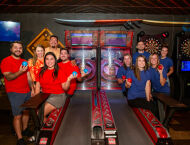Life
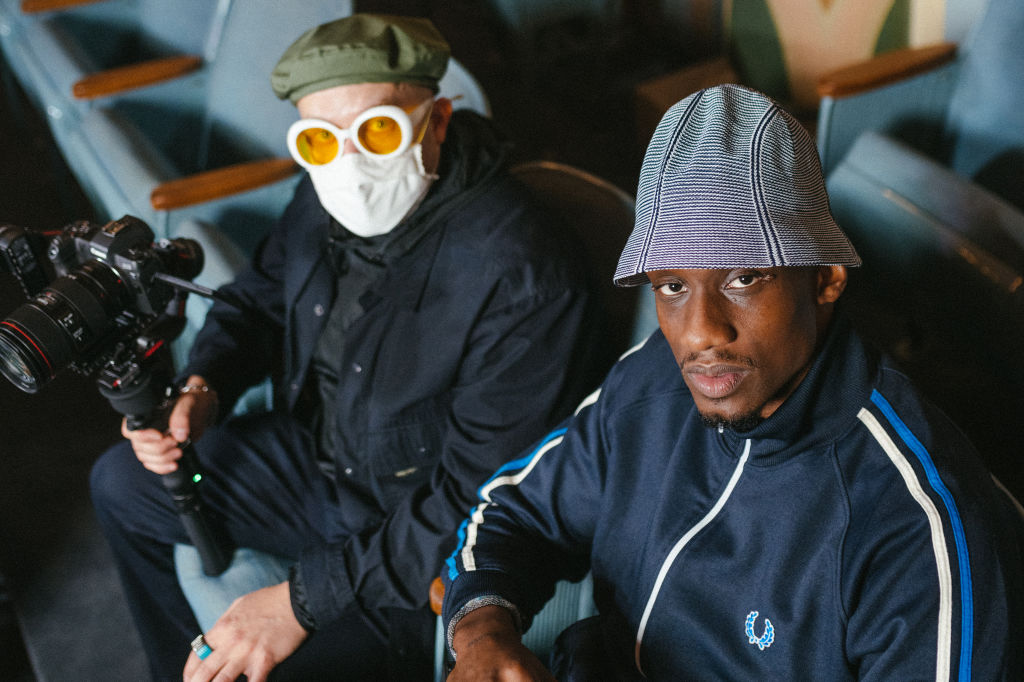 (From L to R) Eliud Arbelo II + Pierre Edwards. Photo by Shaughn Cooper.
(From L to R) Eliud Arbelo II + Pierre Edwards. Photo by Shaughn Cooper.
Studio Sonic Forges New Path for Creatives
October 1, 2021 @ 10:00am
Studio Sonic, the new D.C. creative studio led by cofounders Pierre Edwards and Eliud Arbelo II, is iconoclastic, breaking the rules and expectations for a creative studio and forging a new image of how commerce and arts can work together. And they are serious about not taking themselves too seriously.
Studio + Lab = Art
“Just get ready for weirdness when it comes to us,” Edwards says. “That’s just how we are.”
The concept for Studio Sonic was developed in 2018 — even printing merch with their logo — but formally launched in June 2020. Located in the Brentwood neighborhood of Northeast D.C. and sharing space with frequent collaborators District Fray Magazine and creative production brand No Kings Collective, their office space is painted like a black box theater, adorned with a set of airplane seats (safety equipment still hanging beneath), a wall of computers and monitors, a series of Arbelo’s multimedia paintings (which he slowly assembles in stolen moments), and Studio Sonic hoodies emblazoned with their motto on garment racks and in cardboard boxes.
Centrally located in this square office is a large, white working table adorned with an exotic peacock-strewn bouquet designed by florist Kelanda Dickerson, Edwards’ fiancé, and an assortment of books showing the depth and breadth of their interests and influences. Among them are a small book about Soviet bus stops rendered in the Brutalist style; an elephant folio chronicling fashion icon Yves Saint Laurent; a scattering of books about interior design, architecture and color selection; a massive tome about auteur filmmaker Stanley Kubrick; and a collection of singer Florence Welch’s poetry.
The inspired weirdness of these creative, artistic and marketing moguls came together as part of a campaign for the John Geiger Co, an independent apparel and sneaker designer. In one clip, a steel worker forges metal in an empty warehouse while a male model wears a series of outfits from the brand, confronting the camera’s gaze with determination and poise. This commercial stands on its own by contrasting high-end streetwear and blue collar ruggedness. It develops another layer when viewed alongside another ad they developed for the brand: an earnest voiceover narrative about Geiger hustling and overcoming adversity overlaid onto images of working-class Pittsburgh.
But, in another commercial for the John Geiger collaboration with nightclub E11EVEN Miami, the action replicates a “Miami Vice” episode complete with yachts speeding across cerulean waters, fast cars and bikini-clad models. The sleek commercial’s denouement exposes the joke: This isn’t a cocaine deal gone right but rather a reveal of a stunning new shoe that everyone at the club is fawning over.
The juxtaposing commercials for the same brand — two all about grit and keeping it real, and the other all flashiness, sexiness and humor — tell us a lot about D.C.’s new creative studio. Their DNA, their fingerprints, are all over everything they create, grounded in a model of authenticity. Like the campaign for John Geiger, so much of their work is imbued in their DIY attitude, hardworking backgrounds and insatiable curiosity for what makes the world beautiful.
“Even when we’re doing client work, we’re never bending to meet them,” says Joe Marshall, Studio Sonic’s freelance copywriter/storyteller and multi-hyphenate creative (actor, standup comic, model and more). “We present who we are and try and filter their needs through our lens. That keeps us true to ourselves and our mission.”
Studio Sonic has worked with major clients including The Atlantic Festival, Smithsonian, ViaComCBS, Motion Picture Association and the Hirshhorn Museum — as well as many independent innovators like John Geiger, No Kings Collective, Just Us Girls and many more. Through graphic design, videography, web design and digital media, they bring their signature style — cool, sleek and hyper-pigmented with dashes of humor or weirdness — to every professional project.
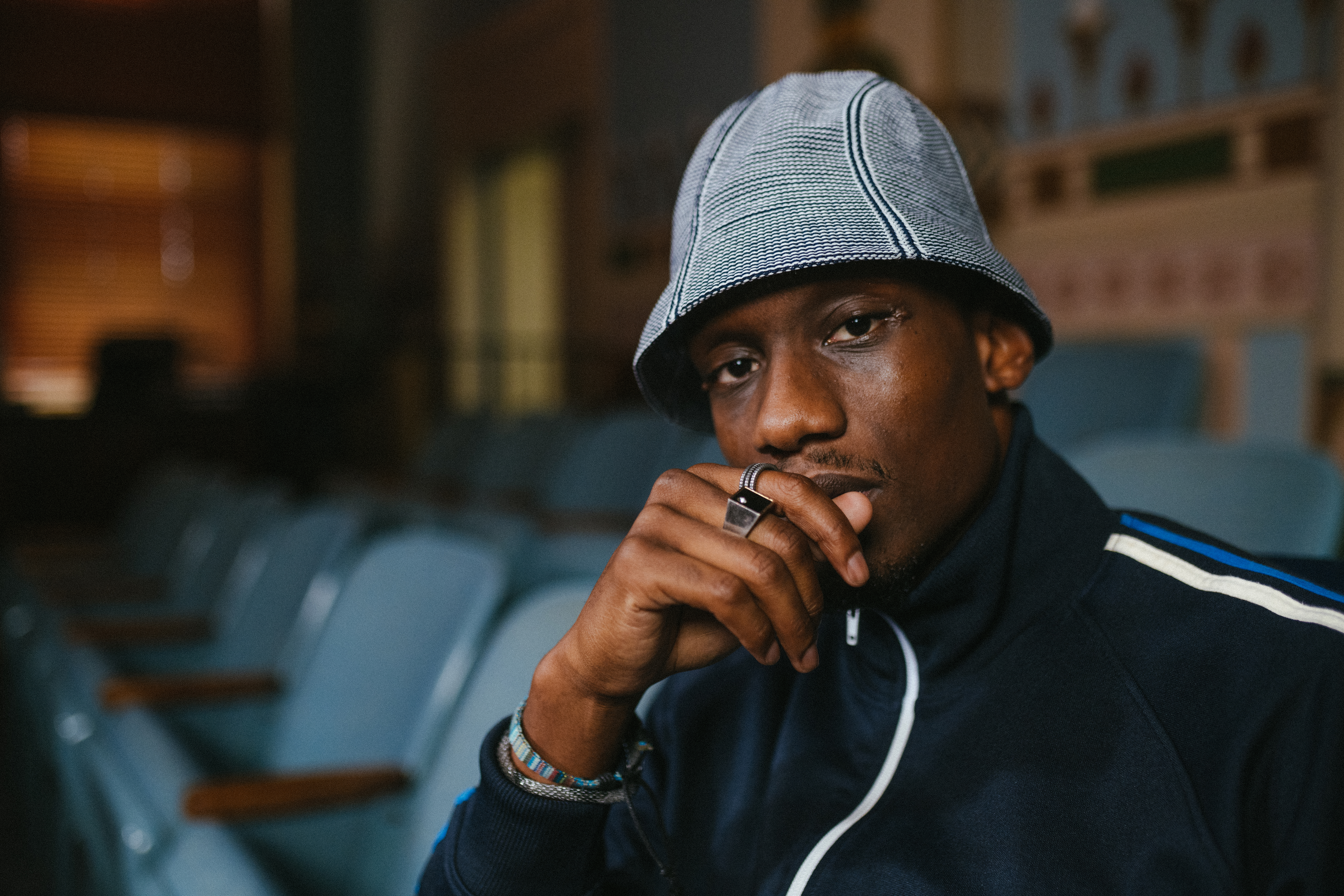
Pierre Edwards. Photo by Shaughn Cooper.
Working Together Creatively
“You put two artists in a room, and either it’s going to be a great connection or there’s probably going to be a UFC fight,” Edwards opines. “There’s no in-between.”
In person, the synergy between these two artists is obvious. Edwards is gregarious, speaks quickly, laughs often and almost always speaks first. Arbelo is more reserved, but his eventual additions are expletive-filled philosophical inquiries. But then something clicks. They soon begin to finish each other’s sentences, alluding to movies and songs they’ve shared with each other, making inside jokes, becoming more contemplative and irreverent. In other words, you know there’s never going to be a UFC-style showdown between these two.
Both grew up in working class families and credit their determination and work ethic to their parents. Born in New Jersey and raised in Florida, Arbelo’s mother is a nurse originally from Santurce, Puerto Rico and his father is a truck driver from Manatí. Edwards, who grew up in Prince George County, was raised by his father, the owner of a construction company, and his mother, a hairstylist. They are also autodidacts, well-versed in DIY culture and lifelong learning.
Shortly after beginning his first semester at Prince George’s Community College, Edwards dropped out. At 19, he bought a cheap camera, getting off at different Metro stops and snapping pictures. He quickly learned his first lesson.
“No one wants to pay photographers, so then I taught myself videography.”
Through YouTube videos and Skillshare, the self-taught Edwards moved into abstract visuals and self-funded his first exhibit of digital and light-based works “In Real Life” at Union Market in January 2019.
“I think we have an MBA in the streets,” Edwards jokes. “We are naturally artists against all odds. There is nothing in either of our paths that would lead to us being artists — no art school experience, no this or that.”
Likewise, Arbelo started to find his footing when he took courses in computer-aided drafting at Indian River Community College while working on his GED in Port St. Lucie. He was eager to leave southern Florida, so he applied to jobs in every big city he could think of. When a political marketing firm in D.C. extended an interview invitation, he drove straight up in his 1989 Nissan Maxima. He changed into his interview clothes in a truck stop, nailed the interview, dined at Ben’s Chili Bowl and headed back down to pack up for good. He stayed at the firm for eight years. Later, he was hired at The Atlantic as a senior designer, but his undeniable skills led to his promotion to design director before he left in 2019.
Edwards and Arbelo were both sought-after freelancers around the District, and eventually found themselves hired as creative directors for the same agency.
“It was terrible,” Arbelo says.
Dissatisfied with their working conditions, they discussed several survival strategies — from working their way up to partner and changing the industry from the inside, or having the agency buy them out to get the funds to start their own studio. But they ended up leaving after just a few months.
“It was a very big gamble, especially at the height of Covid, but we did it,” Arbelo says of starting Studio Sonic.
They pooled their resources, forgoing loans and going deep into credit debt. That’s another thing about Edwards and Arbelo’s upbringing, ethos and hustle. They are weirdo dreamers, but they are also practical business partners.
They acknowledge their art pays the bills. The pair spends a lot of time preplanning projects so they won’t fall into the trap of perpetual perfecting. At the end of the day, they finish their project and move on. They may reflect on a previous project to change their approach next time, but they don’t have a could’ve, should’ve, would’ve mentality. When you’re hustling, you don’t have time for second-guessing.
“We both come from blue collar backgrounds, and we’re very much about working and working super hard,” Edwards explains. “But we need to enjoy what we do, and I think we both have been in scenarios where it wasn’t the funnest to work.”
Frequent collaborators Aaron Tucker and Joe Marshall have known Edwards for years. Both say working feels like play, and the vibe is more hanging out with old friends than breaking stones, even when the hours are long and they’ve been going at a project all day and night.
“We work so many hours,” Arbelo adds. “I don’t want to make anybody feel like this is a drag. Let’s have fun, make jokes and laugh, and listen to good music.”
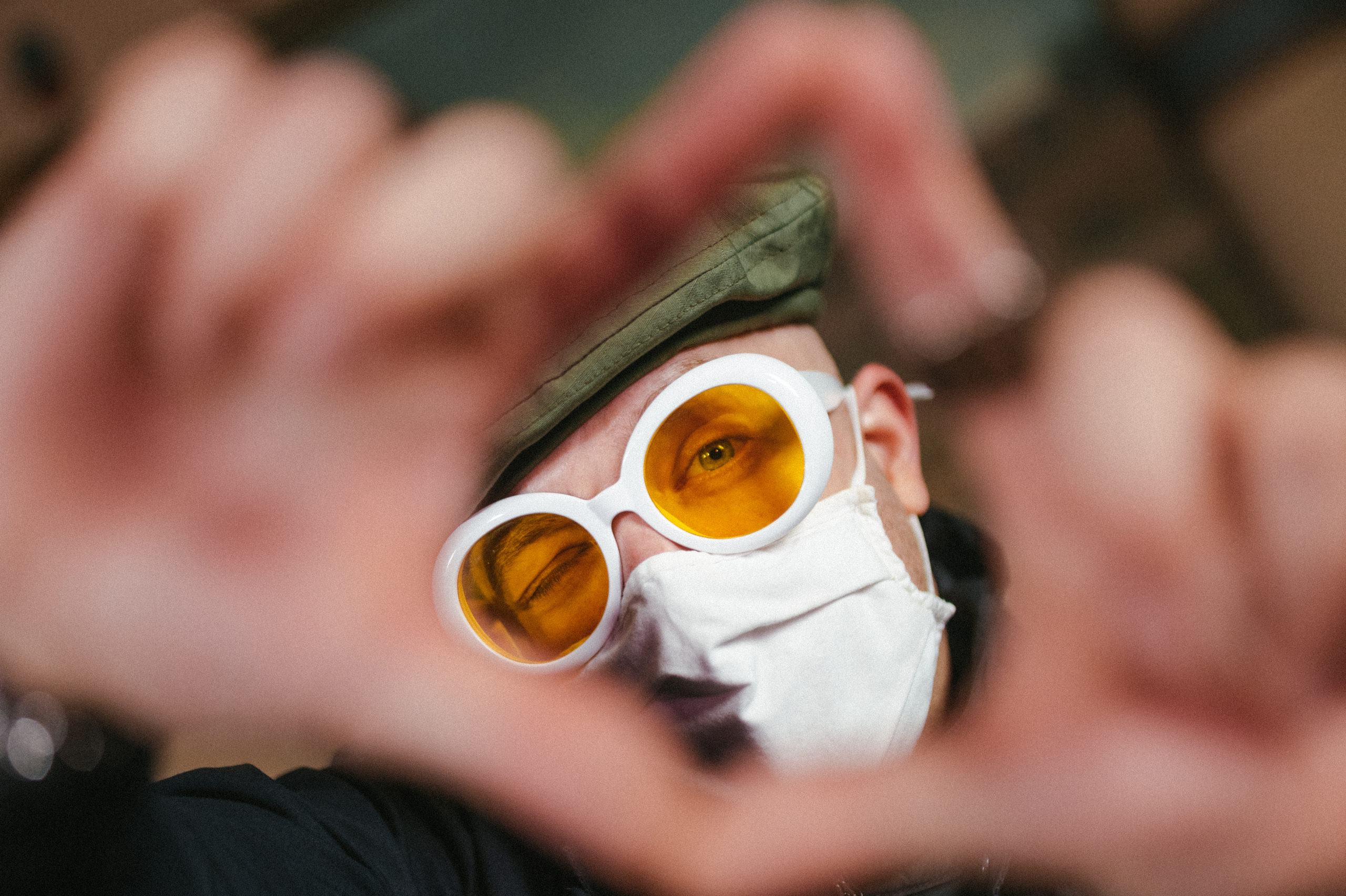
Eliud Arbelo II. Photo by Shaughn Cooper.
The Future + The Past
Tucker, who is a freelance cinematographer for Studio Sonic, says they are “constantly exploring, seeking new information and applying what they learn into their crafts.” Their motto is “the future and the past” because while so much of their creative composition is technologically advanced, their style is infused with an analog nostalgia for pre-cable television, AM radio hits and classic films.
During our roaming conversations, we discuss surrealist Marcel Duchamp, their love for ‘70s songsters The Carpenters, and the belated recognition of graffiti artist Futura 2000. It’s apparent these creatives have an omnivorous appetite for learning and experiencing art and beauty in all its forms. For Arbelo, the only limit is country music after 1997. Edwards gives a special shout-out to No Kings Collective, likening their impact on D.C.’s arts and culture scene to Michael Jordan’s impact on the NBA.
“I personally think they’re the most prolific mural artists to ever exist in D.C. But, bar none, they opened my mind to what art can be, how fun it could be — and that people like me, that look like me, can do it.”
For artist Brandon Hill, for whom they filmed a series of videos in Nashville highlighting No Kings’ collaboration with Audi, the respect is mutual.
“There’s always something unexpected,” Hill says of Studio Sonic’s work. “At first glance, aesthetically, they’re making really sharp, pretty stuff. When pressed, they go down a rabbit hole, pulling back layers and layers and layers like an onion. I love the crispness of it. I love the depth of it.”
All of this — the research, the multiple interviews with clients, the sampling of the campaign’s products, the allusions and references to their media consumption — goes into their painstaking pre-planning process.
“Constant, relentless research,” Arbelo calls it.
Edwards quips, “I think we’re just nerds about the shit we’re into.”
No Sleep Till Brentwood
They don’t just work long hours together in the studio and on shoots. Edwards and Arbelo are chosen family at this point. After leaving their studio, they continue to send texts or call each other late into the night to share ideas or reframe a concept. And their family is now an integral part of Studio Sonic, acting as a sounding board for new ideas, offering inspiration and support, decorating their office, and directing operations. They all regularly spend so much time together that Edwards’ 2-year-old daughter refers to the Arbelos as her aunt and uncle.
“They’re here for dinner all the time, and it’s just a constant feed of ideas and creative conversations,” says Dickerson. “We’re both very into hosting — that’s one thing about Pierre and El, they do everything with a high level of taste. Even if it’s just a quick dinner together, it’s going to look nice, have the best alcohol, just be the best. It’s just how they do anything. The conversations definitely bounce around from work stuff to art shows to new random bands they just discovered.”
A recent trip to Palm Springs combined a family-friendly vacation, client meeting in Los Angeles, creative retreat for the extended team of Studio Sonic and, as always, an opportunity to create some new art.
“They filmed a bunch of shit,” Arbelo’s wife Allie, who works full-time at a political communications firm and directs Studio Sonic’s operations, says with a laugh. “They made shirts. They filmed us playing bocce and they put it out there, turning that moment into these beautiful lasting pieces that are now becoming the brand and the identity of Studio Sonic. It’s incredible.”
The video “Muses in the Abstract” documents that trip, complete with throwback opening credits. It’s decidedly low-fi tropical, pastel-colored vacation footage intercut with images of food and drinks, pleasure and work, an acid trip bocce game with a killer score. It marries nostalgia for old family vacation slide shows with some je ne sais quoi to create something futuristic, funky and fresh.
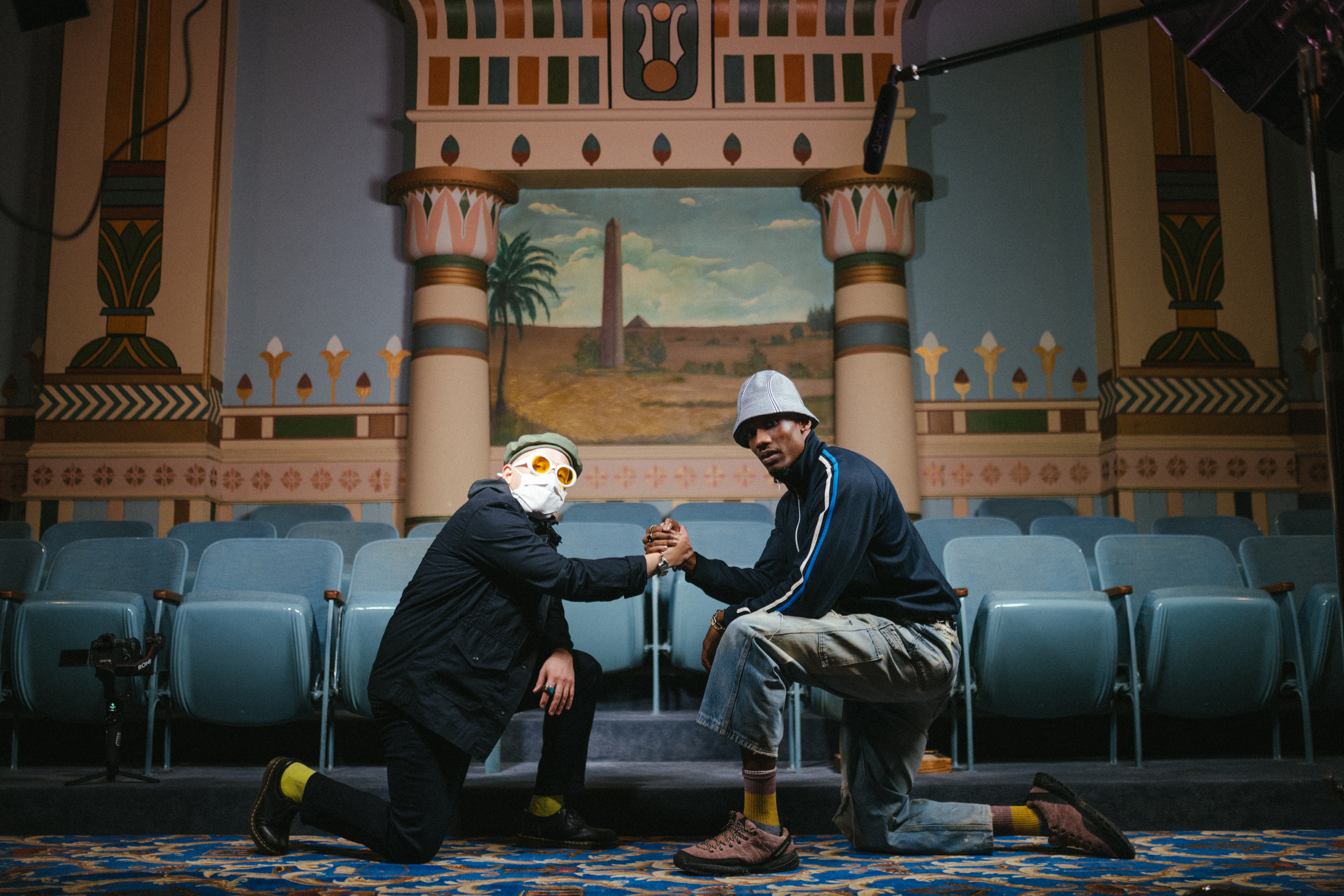
(From L to R) Eliud Arbelo II + Pierre Edwards. Photo by Shaughn Cooper.
A Meta Cover Shoot
Observing Edwards and Arbelo working together on the cover shoot for this month’s issue, you can observe their complementary nature, their yin and yang, their ebb and flow. Arbelo opens a playlist starting with Alice Coltrane’s fitting “Blue Nile” while unloading their gear. Edwards checks shutter speeds, aperture and lighting options, with Arbelo stepping into model for shots before they meet to look over everything, readjust and try again. Their visions and aesthetics are aligned, but it’s easy to see where they differ in their temperaments and approaches.
Edwards is tall and stately, wearing a vintage Fred Perry track jacket with distressed jeans, a textured bucket hat and a fistful of rings — giving off the vibe of an old-school DJ. He breaks into dance between setups to their “The Tail End of Summer” Spotify playlist and cracks jokes to anyone nearby. But he snaps back to professional mode in a heartbeat — adjusting lights, looking through footage or discussing a shot. Arbelo has the compact build of a kickboxer (he’s been training for years) and is enigmatic, wearing a dark ensemble, green beret, Elton John-worthy sunglasses purchased from a Californian gas station, and his face mask throughout the shoot. Even in Studio Sonic promotional materials, Arbelo’s face is often pixilated or otherwise obscured. Arbelo stays focused and serene during the shoot.
The metatheatrical concept is a multilayered final photo with the two members of Studio Sonic multiplied into their own doppelgängers prepping on set and shooting themselves as the cover stars. It’s apparent how much they trust their concept will come together by their choice of Shaughn Cooper, a photographer with whom they have worked previously, even conceding control when he recommends more closeup portraits. Arbelo takes the opportunity to grab his phone and film Cooper taking Edwards’ photo to add more meta layers of self-documenting and art-as-life visual metaphors.
The setting for the cover shoot captures their spirit: a bit oddball, well-researched, unexpected. The top floor of the Naval Lodge in Capitol Hill is saturated with arcane Masonic symbolism. A mural depicting ancient Egypt and hieroglyphics covers the walls, all the way up to the decorated ceiling.
“I feel like the colors, the brightness and the space — it’s me,” Edwards explains. “But the contrast and the texture is more El.”
“Please Bring”
As I am visiting in their studio, they are busy designing three different websites and editing videos and graphic designs for several new clients. One of their current big projects is filming and editing “Please Bring,” a new 10-episode series developed with GATHER by Events DC, No Kings Collective and catering and event services company Please Bring Chips celebrating the District’s culinary cultures. This is an opportunity to bring together all of their talents while amplifying other creatives in D.C.
They just had a video installation at the No Kings Collective-led Franklin Block Party x Art All Night on September 25 and will have another at No Kings’ three-day pop-up, UMBRELLA, on November 12-14. We also discuss some top-secret projects and soon-to-be-divulged collaboration plans. But for now, living this artful life where work and family, business and beauty blend together is enough.
“At the end of the day, we’re just making stuff that goes into the ether,” Arbelo says with a grain of salt.
Edwards asks, “Do you know who the richest man in the world was in 1937? No? Exactly. It sounds grim, but it’s empowering. Anything we feel is a big deal is really not. Let’s just have fun in the process of this, and then move on to the next thing and try to have fun with that. Just keep on rolling and see where it goes.”
Learn more about Studio Sonic at studiosonic.co and follow them on Instagram @studiosonic.co. Listen to their “The Tail End of Summer” Spotify playlist here.
Enjoy this piece? Consider becoming a member for access to our premium digital content. Support local journalism and start your membership today.



